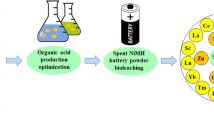Abstract
In the present work, the effects of different energy substrates and nickel ions (Ni2+) and cadmium ions (Cd2+) on the growth of Acidithiobacillus ferrooxidans (A. ferrooxidans) were investigated. Ferrous sulphate (FeSO4) was the optimum energy substrate for A. ferrooxidans growth, among the selected substrates. When cultured together with FeSO4 and sulphur (S), A. ferrooxidans first oxidised the ferrous ions (Fe2+), and the S was utilised as the concentration of Fe2+ decreased. After adapting to culture with Ni2+ and Cd2+, A. ferrooxidans presented good tolerance to both ions, with the maximum concentration reaching 4.11 g/L Ni2+ and 1.69 g/L Cd2+. A preliminary simulation of industrial application was also performed on used Ni-Cd batteries. With bioleaching, the highest concentrations of Cd2+ and Ni2+ were 3003 mg/L at day 8 and 1863 mg/L at day 14, respectively.









Similar content being viewed by others
References
Morrow, H. (2003). Cadmium 2003 batteries, China and the European Commission. In Metal Bulletin 14th International Minor Metals Seminar. Kowloon Shangri-La Hotel.
Vassura, I., Morselli, L., Bernardi, E., & Passarini, F. (2009). Chemical characterisation of spent rechargeable batteries. Waste Management, 29(8), 2332–2335.
Arshadi, M., & Mousavi, S. (2015). Multi-objective optimization of heavy metals bioleaching from discarded mobile phone PCBs: simultaneous Cu and Ni recovery using Acidithiobacillus ferrooxidans. Separation and Purification Technology, 147, 210–219.
Kim, M., Seo, J., Choi, Y., & Kim, G. (2016). Bioleaching of spent Zn–Mn or Ni–Cd batteries by Aspergillus species. Waste Management, 51, 168–173.
Ijadi Bajestani, M., Mousavi, S. M., & Shojaosadati, S. A. (2014). Bioleaching of heavy metals from spent household batteries using Acidithiobacillus ferrooxidans: statistical evaluation and optimization. Separation and Purification Technology, 132, 309–316.
Zhang, S., Yan, L., Xing, W., Chen, P., Zhang, Y., & Wang, W. (2018). Acidithiobacillus ferrooxidans and its potential application. Extremophiles, 22(4), 563–579.
Rawlings, D. E. (2005). Characteristics and adaptability of iron-and sulfur-oxidizing microorganisms used for the recovery of metals from minerals and their concentrates. Microbial Cell Factories, 4, 13.
Nestor, D., Valdivia, U., & Chaves, A. P. (2001). Mechanisms of bioleaching of a refractory mineral of gold with Thiobacillus ferrooxidans. International Journal of Mineral Processing, 62, 187–198.
Gao, S., Luo, X., Nie, E., Zheng, G., Zheng, Z., Chen, G., & Feng, J. (2010). Role of Acidithiobacillus ferrooxidans in bioleaching of copper. Chinese Journal of Environmental Engineering, 3, 677–682.
Wang, B., Yuan, X., Han, L., Wang, X., & Zhang, L. (2015). Release and bioavailability of heavy metals in three typical mafic tailings under the action of Bacillus mucilaginosus and Thiobacillus ferrooxidans. Environmental Earth Sciences, 74, 5087–5096.
San Martín, F., Kracht, W., & Vargas, T. (2018). Biodepression of pyrite using Acidithiobacillus ferrooxidans in seawater. Minerals Engineering, 117, 127–131.
Suzuki, I., Takeuchi, T. L., Yuthasastrakosol, T. D., & Oh, J. K. (1990). Ferrous iron and sulfur oxidation and ferric iron reduction activities of Thiobacillus ferrooxidans are affected by growth on ferrous iron, sulfur, or a sulfide ore. Applied and Environmental Microbiology, 56(6), 1620–1626.
Malhotra, S., Tankhiwale, A., Rajvaidya, A., & Pandey, R. (2002). Optimal conditions for bio-oxidation of ferrous ions to ferric ions using Thiobacillus ferrooxidans. Bioresource Technology, 85(3), 225–234.
Chandraprabha, M., & Natarajan, K. (2013). Role of outer membrane exopolymers of Acidithiobacillus ferrooxidans in adsorption of cells onto pyrite and chalcopyrite. International Journal of Mineral Processing, 123, 152–157.
Johnson, D. B., & Hallberg, K. B. (2009). Carbon, iron and sulfur metabolism in acidophilic micro-organisms. Advances in Microbial Physiology, 54, 201–255.
Silverman, M. P., & Lundgren, D. G. (1959). Studies on the chemoautotrophic iron bacterium Ferrobacillus ferrooxidans: I. An improved medium and a harvesting procedure for securing high cell yields. Journal of Bacteriology, 77, 642.
Mahandra, H., Singh, R., & Gupta, B. (2018). Recycling of Zn-C and Ni-Cd spent batteries using Cyphos IL 104 via hydrometallurgical route. Journal of Cleaner Production, 172, 133–142.
(USEPA), U. E. P. A (1986) Test methods for evaluating solid waste, Laboratory Manual Physical/Chemical Methods.
Zhu, N., Zhang, L., Li, C., & Cai, C. (2003). Recycling of spent nickel–cadmium batteries based on bioleaching process. Waste Management, 23(8), 703–708.
Zhang, J., Fan, W. P., Fang, P., & Xia, C. (2001). Effect of substrates on bio-oxidation catalyzed by T. ferrooxidans. Journal of Nanjing University of Chemical Technology, 23, 37–41.
Minamino, T., Imae, Y., Oosawa, F., Kobayashi, Y., & Oosawa, K. (2003). Effect of intracellular pH on rotational speed of bacterial flagellar motors. Journal of Bacteriology, 185, 1190–1194.
Booth, I. R. (1985). Regulation of cytoplasmic pH in bacteria. Microbiological Reviews, 49(4), 359–378.
Velgosová, O., Kaduková, J., Marcinčáková, R., Palfy, P., & Trpčevská, J. (2013). Influence of H2SO4 and ferric iron on Cd bioleaching from spent Ni–Cd batteries. Waste Management, 33(2), 456–461.
Masindi, V., & Muedi, K. L. (2018). Environmental contamination by heavy metals (pp. 115–133). Aglan: Heavy Metals; IntechOpen.
Funding
This study was funded by the Independent Innovation Project funded by the Ministry of Education-Ecological and Environmental Restoration and Protection (2018ZZCX12).
Author information
Authors and Affiliations
Corresponding author
Ethics declarations
Conflict of Interest
The authors declare that they have no conflict of interest.
Additional information
Publisher’s Note
Springer Nature remains neutral with regard to jurisdictional claims in published maps and institutional affiliations.
Rights and permissions
About this article
Cite this article
Yu, ZJ., Li, H., Yao, JH. et al. Effects of Different Energy Substrates and Nickel and Cadmium Ions on the Growth of Acidithiobacillus ferrooxidans and Its Application for Disposal of Ni-Cd Batteries. Appl Biochem Biotechnol 191, 387–396 (2020). https://doi.org/10.1007/s12010-020-03251-8
Received:
Accepted:
Published:
Issue Date:
DOI: https://doi.org/10.1007/s12010-020-03251-8




